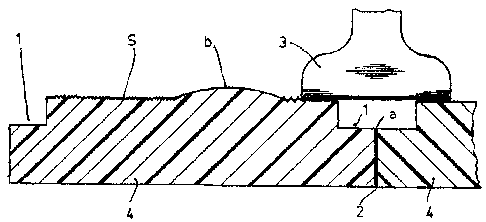Some of the information on this Web page has been provided by external sources. The Government of Canada is not responsible for the accuracy, reliability or currency of the information supplied by external sources. Users wishing to rely upon this information should consult directly with the source of the information. Content provided by external sources is not subject to official languages, privacy and accessibility requirements.
Any discrepancies in the text and image of the Claims and Abstract are due to differing posting times. Text of the Claims and Abstract are posted:
| (12) Patent: | (11) CA 2628655 |
|---|---|
| (54) English Title: | DIRECT LAMINATED FLOOR |
| (54) French Title: | REVETEMENT DE SOL STRATIFIE |
| Status: | Expired and beyond the Period of Reversal |
| (51) International Patent Classification (IPC): |
|
|---|---|
| (72) Inventors : |
|
| (73) Owners : |
|
| (71) Applicants : |
|
| (74) Agent: | SMART & BIGGAR LP |
| (74) Associate agent: | |
| (45) Issued: | 2009-10-20 |
| (22) Filed Date: | 1999-11-25 |
| (41) Open to Public Inspection: | 2001-05-10 |
| Examination requested: | 2008-05-13 |
| Availability of licence: | N/A |
| Dedicated to the Public: | N/A |
| (25) Language of filing: | English |
| Patent Cooperation Treaty (PCT): | No |
|---|
| (30) Application Priority Data: | ||||||
|---|---|---|---|---|---|---|
|
New direct laminated floor, of the kind that contain, on their surface, cellulose sheets impregnated in polymerisable resins, on which some characteristics have been drawn and where, once pressed and mechanised, the finished strips have an offset/sunk area on the peripheral edge and the optic/tactile texture of the surface corresponds and adapts to the characteristics drawn on the cellulose sheets. For application in the construction industry.
Nouveau revêtement de sol direct, stratifié, du type contenant sur sa surface des feuilles de cellulose imprégnées dans des résines polymérisables, comportant certains motifs et où, une fois pressées et mécanisées, les lames finies présentent une zone décalée/encastrée sur la rive périphérique et la texture visuelle/tactile de la surface correspond aux motifs dessinés sur les feuilles de cellulose et s'y adaptent. Pour applications dans l'industrie de la construction.
Note: Claims are shown in the official language in which they were submitted.
Note: Descriptions are shown in the official language in which they were submitted.

2024-08-01:As part of the Next Generation Patents (NGP) transition, the Canadian Patents Database (CPD) now contains a more detailed Event History, which replicates the Event Log of our new back-office solution.
Please note that "Inactive:" events refers to events no longer in use in our new back-office solution.
For a clearer understanding of the status of the application/patent presented on this page, the site Disclaimer , as well as the definitions for Patent , Event History , Maintenance Fee and Payment History should be consulted.
| Description | Date |
|---|---|
| Time Limit for Reversal Expired | 2019-11-25 |
| Change of Address or Method of Correspondence Request Received | 2019-11-20 |
| Common Representative Appointed | 2019-10-30 |
| Common Representative Appointed | 2019-10-30 |
| Letter Sent | 2018-11-26 |
| Letter Sent | 2014-04-25 |
| Grant by Issuance | 2009-10-20 |
| Inactive: Cover page published | 2009-10-19 |
| Pre-grant | 2009-08-10 |
| Inactive: Final fee received | 2009-08-10 |
| Letter Sent | 2009-02-24 |
| Notice of Allowance is Issued | 2009-02-24 |
| Notice of Allowance is Issued | 2009-02-24 |
| Inactive: Approved for allowance (AFA) | 2009-02-16 |
| Amendment Received - Voluntary Amendment | 2009-01-13 |
| Amendment Received - Voluntary Amendment | 2009-01-02 |
| Inactive: S.30(2) Rules - Examiner requisition | 2008-07-02 |
| Inactive: Cover page published | 2008-06-26 |
| Letter sent | 2008-06-09 |
| Advanced Examination Determined Compliant - paragraph 84(1)(a) of the Patent Rules | 2008-06-09 |
| Inactive: Office letter | 2008-06-04 |
| Letter sent | 2008-06-03 |
| Inactive: IPC assigned | 2008-06-02 |
| Inactive: IPC assigned | 2008-06-02 |
| Inactive: IPC assigned | 2008-05-30 |
| Inactive: IPC assigned | 2008-05-30 |
| Inactive: First IPC assigned | 2008-05-30 |
| Inactive: IPC assigned | 2008-05-30 |
| Inactive: IPC assigned | 2008-05-30 |
| Divisional Requirements Determined Compliant | 2008-05-28 |
| Letter Sent | 2008-05-28 |
| Application Received - Regular National | 2008-05-28 |
| All Requirements for Examination Determined Compliant | 2008-05-13 |
| Request for Examination Requirements Determined Compliant | 2008-05-13 |
| Inactive: Advanced examination (SO) fee processed | 2008-05-13 |
| Application Received - Divisional | 2008-05-13 |
| Inactive: Single transfer | 2002-10-10 |
| Application Published (Open to Public Inspection) | 2001-05-10 |
There is no abandonment history.
The last payment was received on 2008-05-13
Note : If the full payment has not been received on or before the date indicated, a further fee may be required which may be one of the following
Patent fees are adjusted on the 1st of January every year. The amounts above are the current amounts if received by December 31 of the current year.
Please refer to the CIPO
Patent Fees
web page to see all current fee amounts.
Note: Records showing the ownership history in alphabetical order.
| Current Owners on Record |
|---|
| FAUS GROUP, INC. |
| Past Owners on Record |
|---|
| EUGENIO CRUZ GARCIA |